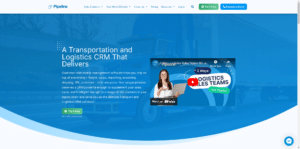Rainier Custom Homes shortened their sales cycle by 53%.
It took 130 days (4.2 months), on average, for them to close a single deal. That all changed when they implemented CRM in their business. In a few short months, their average time-to-close decreased to 62 days.
This had a huge positive impact on cash flow.
Rainier used CRM to attract more customers in less time, increase revenues, and dramatically improve customer relationships.
And that’s the problem.
Most companies aren’t seeing the same gains with their CRM program.
What is CRM?
Customer Relationship Management (CRM) is a process businesses can use to build strong relationships with customers. As a process, CRM gives businesses a simple way to manage customer relationships, contacts, and the feedback brands receive from customers.
CRM software brings all of your customer data into a single, centralized location, so your team can access the same information.
This could be:
- Data from your sales calls
- Text messages from customers or via marketing campaigns
- Direct messages received via social media
- Accounting data (need-to-know basis)
- Email marketing list data
- Help desk, call center, or customer support feedback
The easiest and most efficient way to do this is with software.
Why bother though?
According to the Edelman Trust Barometer, 56% of people worry that business leaders are purposely trying to mislead people by saying things they know are false or gross exaggerations.
Your customer’s default is distrust.
If customers don’t feel they can trust your business, they typically aren’t willing to spend money with your business. They won’t be loyal, and they certainly won’t promote your business. This lack of trust makes everything harder and more expensive for your business.
- Sales teams struggle to sell to customers
- Marketing teams struggle to create messages that fail to convert sales prospects into customers
- Advertising costs skyrocket as marketing focuses on issues customers don’t care about
- Customer support teams are forced to deal with the same problems over and over again
- Customer satisfaction will continually decline as customers are alienated over time
Trust is the starting point.
In the past, companies focused on product value as a way to build and maintain customer loyalty.
Not anymore.
There are too many options, too many products and services to choose from. In the information age, trust is a key component of customer relationship success. When customers trust your company:
- 95% say they’re more likely to be loyal
- 93% state they’re more likely to recommend your company
- 92% state that they’re more likely to buy more products and services
- 91% spend more frequently
- 88% spend more money
- 86% share their feedback and experience with other potential customers
Bain & Company research finds a 5% increase in customer retention boosts lifetime customer profits 50%, on average, across industries, and up to 90% in industries like insurance.
How CRM increases customer trust
CRM software is a listening tool.
When you collect and analyze your customer data, you get a clear understanding of what customers actually want on a moment-to-moment basis; this gives you the power to personalize customer interactions profitably.
Here’s why personalization matters.
- 52% of customers expect offers to always be personalized (up from 49% in 2019)
- 66% of customers expect companies to understand their specific wants and needs
- 66% of customers expect companies to understand their needs; 66% say they’re treated like numbers
- 66% of business buyers and 62% of consumers prefer personalization
- 70% of customers say that how well a company understands their individual needs impacts their loyalty
- 80% of customers are more likely to buy from a company that provides a tailored experience
CRM gives you the ability to personalize.
You’re able to:
(a.) listen to customer feedback and observe their behavior across all communication channels.
(b.) monitor customer trends and behavior
(c.) make efficient, actionable changes that customers actually want.
The benefits of CRM
When it comes to CRM, there are lots of benefits. If a CRM system is used consistently, it has the power to transform your business radically. With CRM, you can:
- Identify your customers’ desires, goals, fears, frustrations, and problems
- Map customer expectations, including objections that are fuzzy, implicit, and unrealistic
- Spot hidden customer objections and dealbreakers ahead of time
- Discover how to personalize communication across each sales, marketing, or customer service touchpoint
- Focus your attention on the goals and objectives that matter most to customers
- Communicate in a way that commands attention and drives revenue
- Generate and disqualify leads faster, shorten sales cycles, and close more deals
- Prioritize leads that are sales-ready, send other leads to marketing for follow-up
- Spending more time with the right prospects and less time with the wrong prospects
- Improving customer support and response times
- Automate key processes across multiple departments (e.g., handling customer objections)
- Align business and customer goals and objectives
- Sharing specific and precise details about each individual customer at scale with your entire organization
- Create sales and marketing content specific to each customer segment
The benefits that come with a solid sales CRM are consistent and significant, but it depends on your organization’s ability to collect customer data consistently. These benefits are attainable, it just takes a little effort.
The various types of CRM
CRM programs can be approached from various levels —macro, meso, and micro. You may find that various sections of your business use CRM in several ways.
Let’s take a look.
- Strategic: This is a macro, high-level view of CRM. Managers, directors, or executives are focused on the strategic development of a company-wide, customer-centric culture. CRM at this level improves long-term metrics (e.g., customer lifetime value, average order values, monthly recurring revenue, etc.).
- Operational: This is a meso level view of CRM that’s focused on three areas — sales, marketing, and service/support automation. When organizations think about CRM, they’re usually approaching it from this standpoint. Companies at this level rely on CRM software to provide customer data, past sales, and relationships with customers.
- Analytical: This is a macro, meso, and micro-level view of CRM. CRM analytics harvests customer data and presents it in a format that managers can use to make decisions. At this level, managers are focused on analyzing trends, patterns, and behavior. You’re essentially using CRM to answer questions (e.g., why do sales prospects ghost us when we send them a quote? Why are new customers spending more money on these products?). Your CRM works best when it’s integrated with other analysis tools like Google Analytics or HelpScout.
- Collaborative: This approach focuses on internal and external dialogue — tech support sharing common customer complaints with sales; sales using that data to improve their pitch, which marketing incorporates into official sales copy.
Which type of CRM is best for you?
It’s a trick question.
If you plan on maximizing the value you receive from CRM, you’ll need all four. Maybe you’ll rely on operational CRM more than the others, that’s okay. You’re still going to need these four, in some capacity, to grow your business.
Why most companies using CRM fail to see results
Scott Edinger made a pretty grim statement in his article.
“In 2017, CIO magazine reported that around one-third of all customer relationship management (CRM) projects fail. That was actually an average of a dozen analyst reports. The numbers ranged from 18% to 69%. Those failures can mean a lot of things — over-budget, data integrity issues, technology limitations, and so forth. But in my work with clients, when I ask executives if the CRM system is helping their business to grow, the failure rate is closer to 90%.”
BuyerZone found that 91% of companies with more than 11 employees use CRM. They start strong, then eventually, their team stops relying on CRM.
But why?
If CRM can produce the amazing results we’ve seen so far, why is the failure rate
so high?
Edinger shared the answer.
“The primary reason they miss the mark in helping companies increase revenue is that CRM systems are too often used for inspection — to report on progress, improve accuracy of forecasts, provide visibility, predict project delivery dates, and provide a range of other business intelligence — rather than creating improvement in the sales process. Front-line sales professionals and managers rarely find the majority of these capabilities useful in winning more business for the company.”
Did you catch that?
Operational CRM, the area that increases sales, often gets neglected in favor of the other three types.
That’s bad news.
How can you succeed where others have failed? How can you use CRM to achieve the results you want for your business?
Change your mindset.
- Treat your CRM as a revenue generator. Your CRM tool is there to generate revenue and increase cash flow. The extras — reports, forecasts, and predictive tools, aren’t the priority.
- Use CRM to combine your sales and marketing. Marketing is angry because sales didn’t follow up with the leads they generated. Sales believe the leads are unqualified due to customer feedback. CRM is the bridge that connects the two. The better sales and marketing work together, the easier it will be to generate revenue.
- Use CRM to coach your team. This isn’t just about a specific individual. It’s not about individual all-stars or poor performers. It’s about the team; use your CRM data to coach and improve the team. If you’re using your CRM software well, you should be able to spot trends, patterns, and behavior that moves you closer to your goal.
If your team uses your CRM the right way, you’ll have a clear sense of the work that needs to be done. Marketing will understand the feedback customers are giving the sales team. Sales will follow up with prospects who are a good fit, and management will see consistent growth in each of your core metrics (conversion, sales, revenue, profit, customer lifetime value, etc.).
Who Should Use a CRM?
It sounds like CRM is really just for sales, marketing, and customer support teams, is that right?
Actually, no.
Human resources, accounting, even IT can manage their contracts, orders, bills, and other types of paperwork using CRM.
It’s easier if you start by integrating your company slowly. First, get sales, marketing, or customer support on board. Then, add new departments as adoption rates stay constant. Integrate your CRM with other tools and apps (e.g., Google Apps, QuickBooks, Mailchimp, Zapier, CallRail, etc.).
Make CRM usage a habit, one department at a time.
The value you receive from your CRM will increase as more of your employees use it consistently.
Using CRM to 2x Your Business
With CRM software, you can create reports with insights, analysis, and forecasting — everything you need to make smart decisions for your business. Use your CRM to close deals or improve the customer experience. Integrate your CRM with your accounting data to help sales identify your best customers.
Can you use your CRM to 2x your business?
Absolutely.
With the right customer data, you can put these urgency triggers to work.
Here are a few ideas.
- Order by [Tuesday, March 4th], and you’ll receive [free product, discount, trial, etc.]
- Trial offer. We’re offering our [service] to the first 10 people who respond today. Reserve your spot now.
- Only [10] left in this year’s batch. Get your [product] now before it’s gone
- Loss aversion timer. This bonus is free until [date], or the price goes up in [2 days, 12 hrs, 41 min.]
- The first 50 customers to pass this test wins a [grand prize]
- Invite/VIP only. Exclusive to members of the [group] club receive these free [products, bonuses, freebies] with their order
- Join the waitlist. Purchase this [product] before our offer expires, and you’ll be added to the waitlist for our [exclusive bonus or incentive]
- Bundled opt-ins. Take our quiz, and you’ll receive this [product or bonus] free with your order.
This depends on specificity.
And specificity comes from your customer data. These urgency triggers give your customers a clear and compelling reason to buy. Not later on. Not next week or sometime in the near future. Now. Right now.
These offers are built on your customer data, and they unite your sales and marketing teams. Marketing can use these tools to generate leads; sales can use these offers, created by marketing, to close deals! All of this is made possible by your customer data collection efforts.
What exactly is CRM? It's a revenue generator
Rainier Custom Homes reduced their sales cycle by 53%; the impact on their cash flow was significant. Their CRM enabled them to identify their customer’s desires, goals, fears, frustrations, and problems.
CRM increased customer trust; it gave them the ability to personalize.
Rainier listened to customer feedback; they observed customer behavior across all communication channels. They used CRM to monitor customer trends and behavior. They used their customer data to make efficient, timely, and actionable changes their customers actually wanted.
You can do it too.
Start with the right CRM tools, and you’ll find you have everything you need to generate revenue and value on demand.




